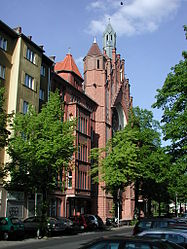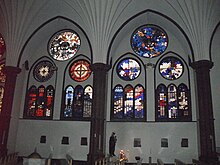Holy Cross Church (Berlin-Wilmersdorf)
| Holy Cross Church | |
|---|---|
|
Portal of the Holy Cross Church |
|
| Construction time: | 1911-1912 |
| Inauguration: | May 12, 1912 |
| Architect : | Max Hasak |
| Style elements : | Brick gothic |
| Client: | Catholic parish of St. Ludwig |
| Location: | 52 ° 28 '55.3 " N , 13 ° 19' 40.6" E |
| Address: | Hildegardstrasse 3a Berlin-Wilmersdorf Berlin , Germany |
| Purpose: | Roman Catholic branch church |
| Parish: | Mary under the cross |
| Diocese : | Archdiocese of Berlin |
| Website: | www.maria-unter-dem-kreuz.de |
The Holy Cross Church in the Berlin district of Wilmersdorf is a Roman Catholic church that was built from 1911 to 1912 according to plans by the architect Max Hasak and incorporated into the northern row of houses on Hildegardstrasse according to the general arrangement of Empress Auguste Viktorias . It is a single nave nave church , faced with red bricks and designed with Gothic elements. The building is a listed building .
History of the church
In order to give the southern part of their district their own place of worship, the mother parish of St. Ludwig acquired the property at Hildegardstrasse 3 in 1907, at that time not far from Schramms Seebad , now near the Wilmersdorf public park . Since Wilmersdorf had just received town charter at the time and was thus the youngest major city in the Empire , an expansion of the Catholic community was urgently required.
In 1911, the bishop's legacy Carl Kleineidam laid the foundation stone for this second Catholic church in Wilmersdorf. After eleven months of construction , the Bishop of Breslau, Georg Cardinal von Kopp consecrated it on May 12, 1912 to the patronage of Finding the Cross .
After the First World War , the church was detached from the mother parish of St. Ludwig on July 1, 1921 and established as an independent parish. The church was badly damaged in World War II . The last war damage was repaired in 1959.
In 1973 the church underwent a fundamental renovation and redesign of the church interior as part of the reforms of the Second Vatican Council . The renovation was carried out under the direction of the architect Felix Fähnrich.
In 2009 the parish Heilig Kreuz was dissolved and became a branch church in the parish Maria unter dem Kreuz with the main church St. Marien .
Furnishing
Sanctuary
The now smaller, freestanding block altar made of sandstone is made up of elements from the former high altar. On the front side, a pelican is shown, who gives himself to his children for food. This is a sign of Christ giving himself away. The "Alpha" and "Omega" medallions are on the side. The altar is surrounded by four pillars made of red marble which still come from the old altar. The relics of the martyrs Pia of Carthage and Placidus of Subiaco , which were placed in the altar in 1912, are also included in the current altar.
The larger-than-life carved wooden body in neo-Romanesque style is part of the equipment from 1912. The figure of Christ is represented as a four-nail type standing on a console. The former richly decorated wooden cross was replaced by a simple bar cross in 1974.
The original tabernacle was integrated in the former high altar and was removed when the interior of the church was redesigned. The sandstone tabernacle stele was designed by the architect Felix Fähnrich, the bas-relief was created by the artist Waldemar Otto . It shows the burning bush with a crown of thorns .
The four round pictures with Eucharistic scenes come from the original high altar from 1912. They are attached in parallel as pairs on the left and right of the chancel wall. They show the following biblical scenes: the sacrifice of Cain and Abel , the sacrifice of Isaac , the sacrifice of Melchizedech and the meal at Emmaus .
The relief busts of the four evangelists adorned the former pulpit.
Statues
The plaster statue of the Madonna comes from the original equipment of the church and was part of a Marian altar, which was located on the right side niche in front of the choir. This side altar has largely been lost.
On the opposite side of the Marien Altar there was a statue of Joseph - also on a side altar. Joseph's altar and statue have not been preserved. Therefore, in 2013 a new statue of Joseph was made in a South Tyrolean workshop in St. Christina . This is made of wood and is now in its original position. It is not a reproduction and is not artistically oriented towards the old one, as there are no exact images of the old statue. However, the design is based on the preserved statue of the Virgin Mary.
The statue of Antonius also dates from the time the church was founded and is made of plaster. It stands in a historical place, on the second front left pillar and was not part of a side altar even then.
Baptismal font, stations of the cross and window
The sandstone font dates from 1912, the lid was created by Waldemar Otto . The Berlin sculptor Günter Anlauf made the Way of the Cross in 1982 . The church windows were designed by the artist Paul Corazolla .
organ
After initial considerations about building a new organ in 1922/1923, the construction project was initially postponed due to the high inflation . After a six-month planning and construction phase, the instrument with two manuals and pedal , with 35 stops and a pneumatic action , was built by the royal court organ builder G. F. Steinmeyer on April 10, 1927 as op.1438 and ceremoniously consecrated by prelate Bernhard Lichtenberg . The later Passau cathedral organist Otto Dunkelberg played at the consecration .
After two general cleanings (1946 and 1963), the instrument underwent a sound and technical modification for the first time in 1973 - by the Berlin organ builder Arndt Stephan in line with the neo-baroque wave. Most of the fundamental sound was retained.
After the church renovation and further cleaning of the instrument in 2001/2002, the church musician Dirk Elsemann advised to come back as close as possible to the original sound of 1927. By purchasing used organ parts from Steinmeyer Vermögensverwaltung , this was made possible by Mr. Elsemann's own work. From 2004 to 2008 the organ was expanded by a third manual (swell mechanism) to 52 stops. Most of the pipe material also comes from Steinmeyer Vermögensverwaltung . The organ has not only regained its romantic appearance, but has also gained a multitude of possibilities.
|
|
|
|
||||||||||||||||||||||||||||||||||||||||||||||||||||||||||||||||||||||||||||||||||||||||||||||||||||||||||||||||||||||||||||||||||||||||||||||||||||||||||||||||||||||||||||||||||||||||||||||||||||||||||||||||||||||||||||||||||
-
Pairing :
- Normal coupling: II / I, III / I, III / II, I / P, II / P, III / P
- Sub-octave coupling: I / I, II / I, II / II, III / I, III / II, III / III
- Super octave coupling: I / I, II / I, II / II, III / I, III / II, III / III, I / P, II / P, III / P, P / P
- Playing aids : two free combinations, piano pedal II, III; Crescendo roller , generaltutti, storage (pedal register, hand register, pipe works), combinations (strings, principals, pipe works)
Bells
On 20 October 1963 dedicated Provost Wolfgang Haendly the third bells in the history of the Church, from the bell foundry . Petit & Gebr Edelbrock was manufactured. The first and second bells had to be given to the military for war purposes and were melted down. A bell survived the world wars and has been hanging in the tower since 1912. It is used as a transformation bell and does not belong to the ringing.
Today's bells are made of bronze and, like the earlier ones, sound on the notes c – es – f ( Te Deum disposition ) . They have the same names as the previous bells.
| Bell jar | Dimensions | volume | Latin inscription | Translation of the Latin inscription |
|---|---|---|---|---|
| St. Thomas | 2500 kg | c | Adoramus Te, et benedicimus Tibi, quia per crucem Tuam redemisti mundum. | We pray to you, Lord Jesus Christ, and praise you, because through your holy cross you have redeemed the world. |
| St. Antonia | 1500 kg | it | Per signum Crucis de inimicis nostris libera nos, Deus noster. | With the sign of the cross, set us free from our enemies, O Lord. |
| St. Carolus Borromeo | 1000 kg | f | In cruce salus. | Salvation is in the cross. |
Pastor of the church
- Paul Schneider (1916–1945)
- Franz Reiseck (1945–1968)
- Helmut Hettwer (1968–1973)
- Jacques Vernooy (1973-2000)
- Christian Vaas (2000-2009)
- Frank-Michael Scheele (since 2009), pastor of Maria under the cross
Church life
A day-care center has been part of the community since 1992 and is located at the rear of the property.
The Archbishop of Berlin, Georg Cardinal Sterzinsky dissolved the Holy Cross parish by decree on July 1, 2009 and merged it with the parish of St. Marien (Immaculate Conception) ( Berlin-Friedenau / Schöneberg ) to form the new large parish Maria under the Cross with around 9500 believers. The parish church has been St. Mary's Church since then, and the Holy Cross Church is now a branch church . The community includes the Berlin districts of Wilmersdorf and Friedenau .
Others
The St. Gertrauden Hospital in Paretzer Strasse , which was inaugurated on November 4, 1930, belongs to the municipality .
Since May 1st, 2010 the Italian Catholic Mission - Berlin (Missione Cattolica Italiana - Berlino) is located in the Holy Cross Church.
literature
- 75 years of Heilig Kreuz Berlin-Wilmersdorf 1912–1987
- Karl-Heinz Metzger: Churches, mosques and synagogues in Wilmersdorf
- Catholic Church Heilig Kreuz Berlin-Wilmersdorf 1912–2012
Web links
- Website of the parish Maria under the cross
- Photos of the Holy Cross Church
- Information on the Steinmeyer-Elsemann organ of the Holy Cross Church
- Entry in the Berlin State Monument List
- Kita Heilig Kreuz
- Italian Catholic Mission - Berlin
- Missione Cattolica Italiana - Berlino
Individual evidence
- ^ The organ in the Heilig-Kreuz-Kirche Berlin-Wilmersdorf , accessed on February 12, 2020.




